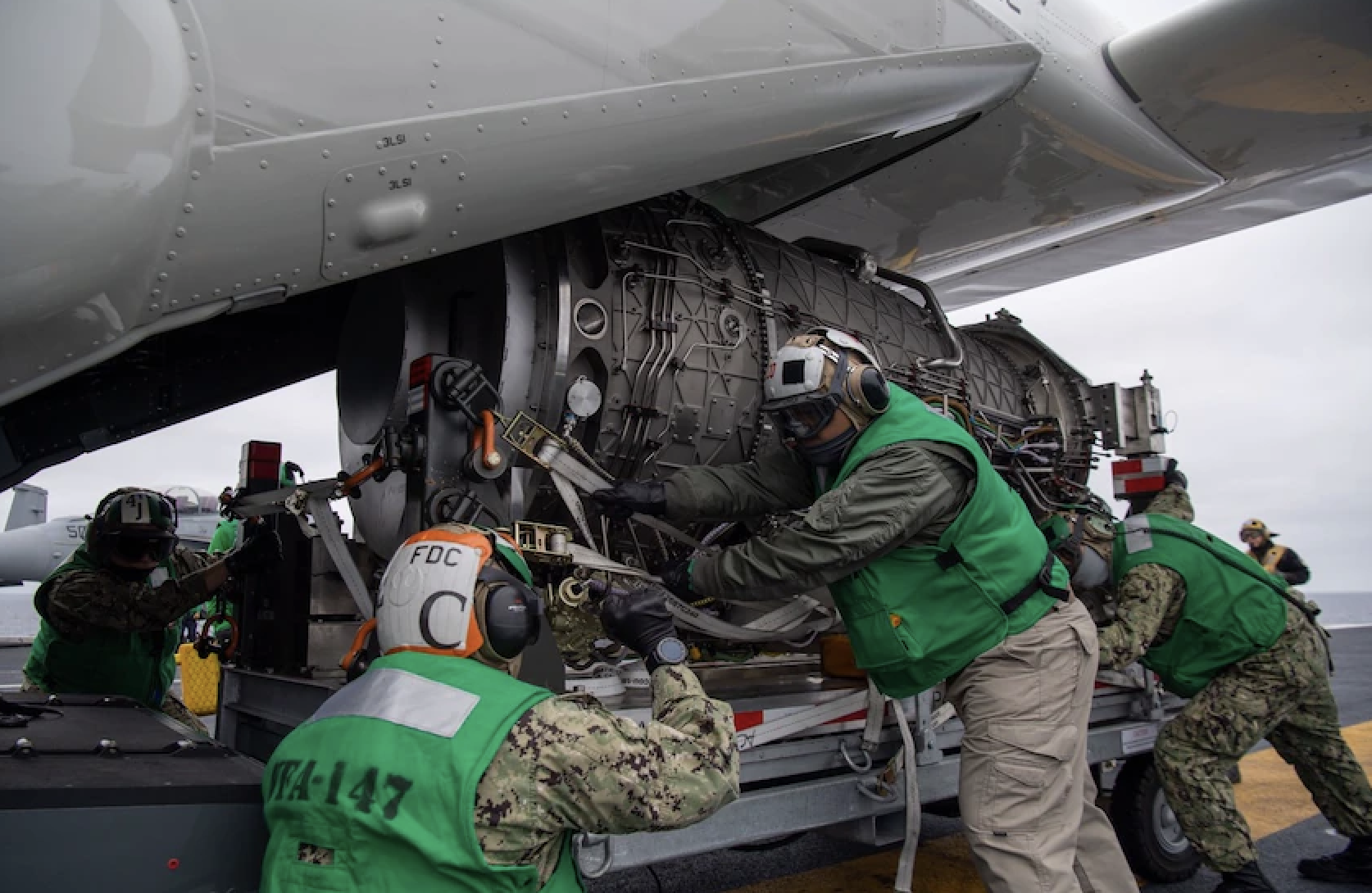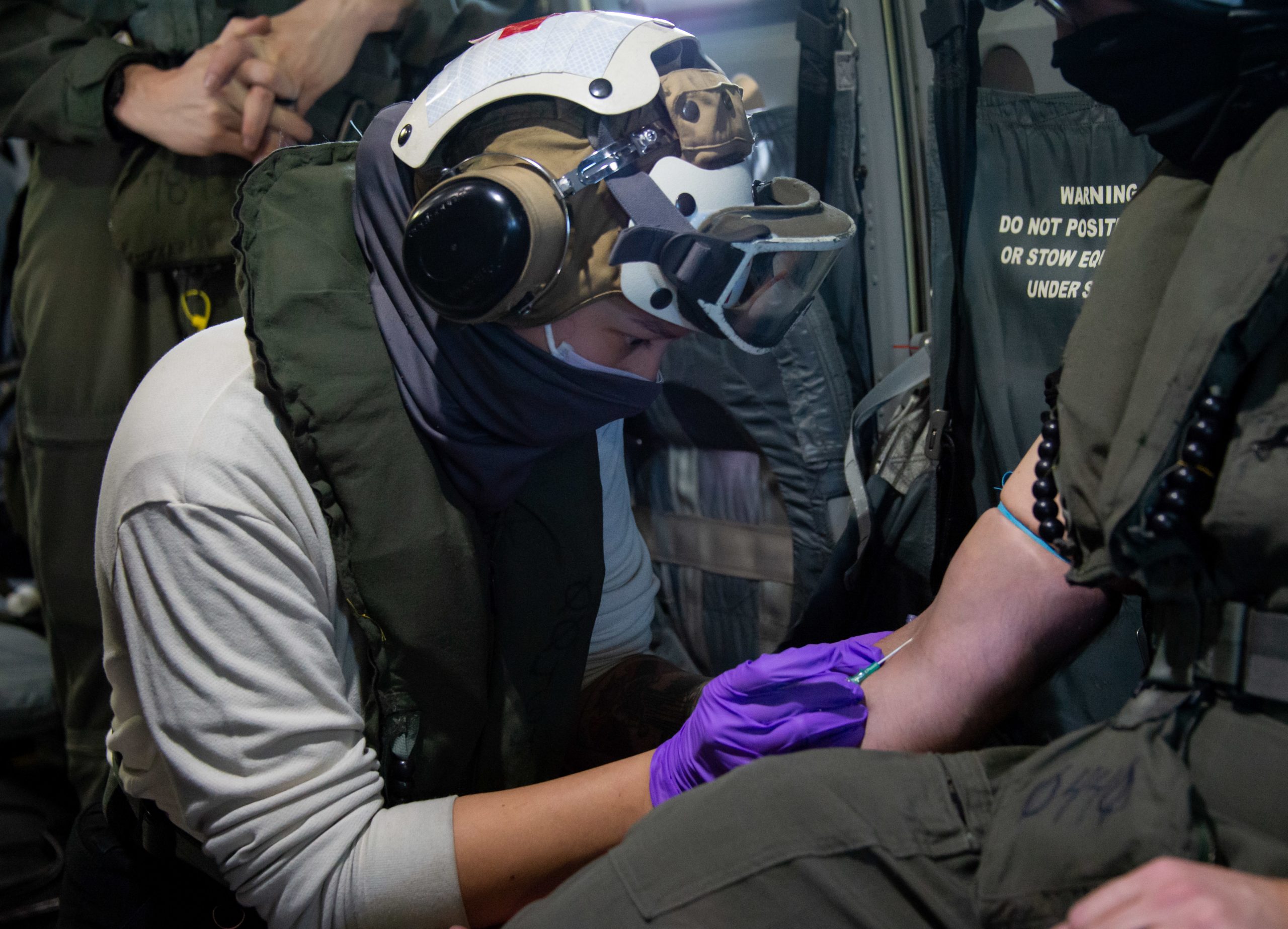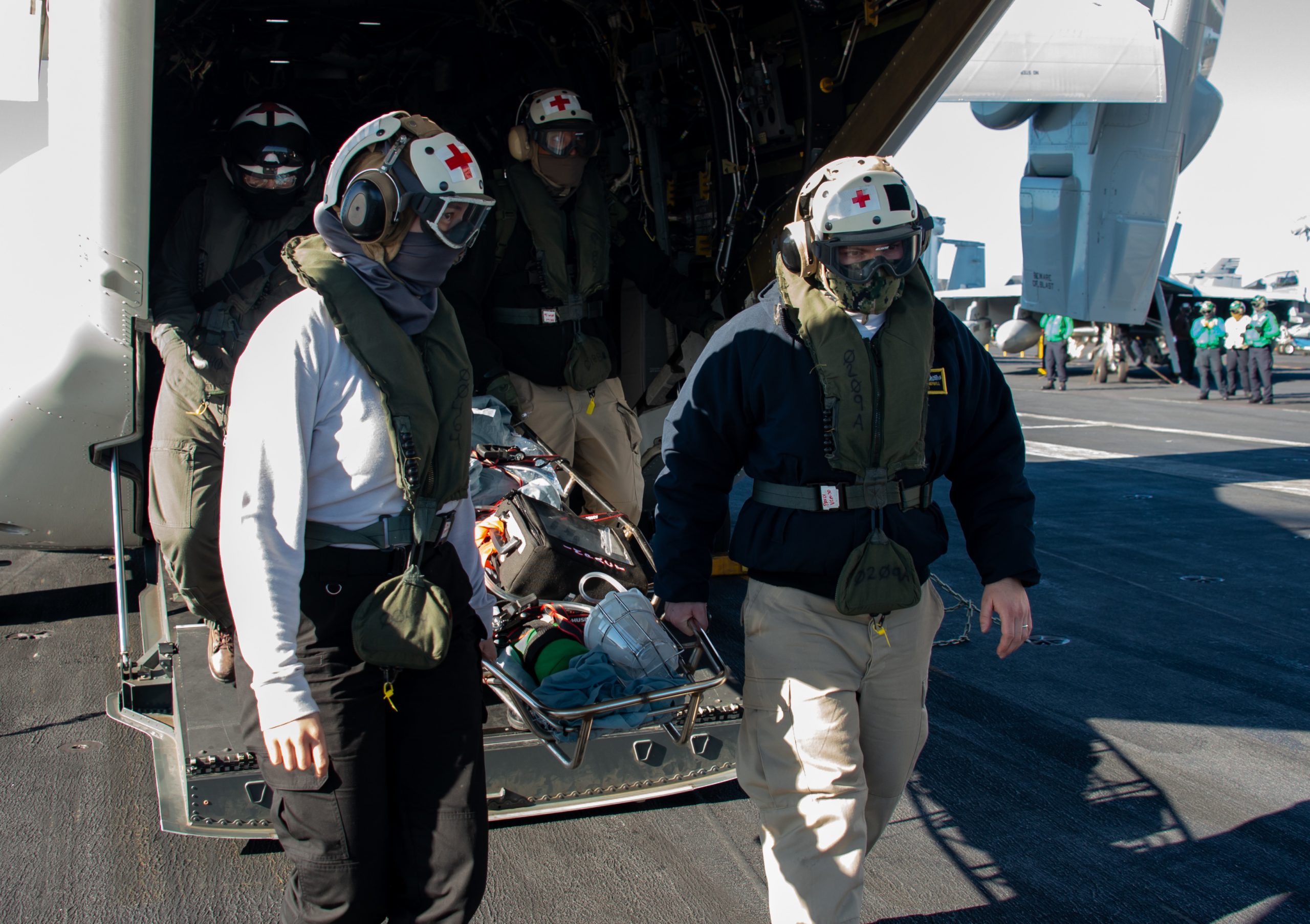By Robbin Laird
The CMV-22B is an essential part of the evolving air wing on the large deck carriers. The process of shaping this new capability is part of the overall transformation of the large deck carrier and its role in the evolving capabilities of the U.S. Navy and its transformation of fighting as a fleet.
New platforms should never be understood as in and of themselves but as part of the evolution of a force, and when significant change is underway, the transformation of the force. This is certainly the case with the CMV-22B.
The Navy has a huge advantage in bringing the lift-focused Osprey to its flight decks. For it builds on the significant operational experience of the USMC in operating this aircraft globally. This means that the Navy is drawing upon the ecosystem associated with the Osprey and taking that platform and its ecosystem onto its evolving large deck carrier fleet.
In a story published by the USS Carl Vinson on February 26, 2021, the operation of the first CMV-22B squadron in delivering an F-35C power module onboard the ship was highlighted.
The “Titans” of Fleet Logistics Multi-Mission Squadron (VRM) 30 and members of Carrier Air Wing (CVW) 2 successfully delivered an F-35C power module aboard USS Carl Vinson (CVN 70) in the U. S. Navy’s first, at-sea replenishment for this component.
This success follows a November 2020 milestone, during which VRM-30, CVW-2 and Vinson conducted the Navy’s first landings, take-offs, and refueling of a Navy CMV-22B Osprey from an aircraft carrier.
The at-sea power module replenishment evolution consisted of loading, transporting and unloading the F135 power module from a shore-based location to the carrier by way of a CMV-22B. The power module is an engine component used by all three F-35 Lightning II variants.
The CMV-22B is the U.S. Navy version of the V-22 Osprey, a multi-engine, dual-piloted, self-deployable, medium lift, vertical takeoff and landing (VTOL) tilt-rotor aircraft. The CMV-22B can transport cargo and passengers as far as 1,150 nautical miles; provides enhanced survivability and beyond-line-of-sight communications; and has the required cargo capacity and fast cargo loading/unloading. Coupled with its ability to transport the F-35 power module inside its cargo bay, CMV-22B is the ideal choice to provide required carrier on-board delivery capabilities for F-35C operations at sea. The delivery marks a milestone in the integration of CMV-22B to the Carrier Air Wing, validates the F135 modular maintenance concept at sea, and most importantly supports future carrier air wing deployments with next-generation platforms.
“The CMV-22B is a great addition to the carrier air wing,” said Capt. Matt Thrasher, commander, CVW-2. “The Osprey is a robust logistical platform that not only supports the F-35C but also gives the entire air wing increased range and transport capacity. Its addition to our team ensures that CVW-2 remains ready to perform as-advertised while on deployment.”
CVW-2 is currently embarked aboard Vinson under the command of Carrier Strike Group (CSG) 1.
CVW-2 is leading the charge in introducing and integrating the next generation of aircraft and capabilities in the Fleet as the U.S. Navy’s first Carrier Air Wing to deploy with the F-35C Lightning II, E-2D Hawkeye and the CMV-22B Osprey. The Navy’s next iteration of the Carrier Air Wing will be more lethal and survivable through the integration of organic fourth-generation kinematics and fifth-generation information and survivability, increased command and control and airborne electronic attack capacity, all sustained with a reliable logistical support platform.
“With the addition of the newest fifth-generation aircraft, the Navy has delivered the world’s most capable, lethal and ready air wing to our strike group,” said Rear Adm. Timothy J. Kott, commander, CSG-1. “Delivering the right balance of presence and power, including airpower supremacy, strike groups continue to be one of our nation’s primary on-call assets in times of need. By maintaining a lethal, ready strike group, manned by the world’s most skilled Sailors and outfitted with the best equipment, fifth generation aircraft will help America maintain our advantage at sea and protect our nation for years to come.”
Capable of embarking both the F-35C and the CMV-22B, Vinson is the first aircraft carrier equipped to support fifth-generation aircraft. With its recent modifications, no other weapons system has the responsiveness, endurance, multi-dimensional might, inherent battlespace awareness or command and control capabilities of the Vinson and CVW-2.
Upgrades included enhanced jet blast deflectors able to take the increased heat generated by the F-35C and the Autonomic Logistics Information System (ALIS), the new computer network that supports the unique maintenance and tactical operations functions of the advanced aircraft.
“Our crews and staffs have done a fantastic job during integrated operations with the new aircraft and associated upgrades,” said Capt. P. Scott Miller, Vinson’s commanding officer. “We are truly a team. The successful replenishment of the power module is another testament to that team and our Sailors, who are the most dedicated, best trained and well educated in the world. The continued professionalism and warfighter spirit they demonstrate each and every day is the number one key to our success time and time again.”
Vinson is currently completing a series of “work ups” and certifications in preparation for future operational tasking.
But the image of the CMV-22B delivering the engine module for the F-35C onboard the Vinson does not reflect the effort to get to this point in preparing the air wing of the future or my preferred term the integratable air wing for the arrival of both the F-35 and the Osprey onboard the next phase of the large deck carrier’s transformation.
The coming of the F-35 to the carrier is part of the enhanced reach of the carrier; the coming of the Navy’s version of the Osprey is part of reshaping the logistics capabilities which the DMO logistics support for the fleet entails. Cross-decking will be a key part of both re-imaging how the large deck carrier and the amphibious fleet can provide for the evolution of sea-basing.[1]
The Navy’s logistics air arm which the CMV-22B is transforming will certainly be able to work across decks in the fleet. This is clearly not something which the legacy aircraft for the logistics mission, the C-2A, could not do.
For example, in the Black Widow exercise last Fall held by Second Fleet, the USS Wasp was part of the USW force. It operated Romeos off of its deck. If did so in a combat situation, those helicopters could be joined with the Link-16 and full motion capable Viper attack helicopter to provide for ship defense. Those aircraft – the Romeos and Vipers – when getting low on the appropriate weapons could be resupplied by an MSC ship, but if not available or not able to provide the appropriate weapons in a timely fashion – could have a CMV-22B land onboard to provide such a capability from a North Atlantic base, from a large deck carrier, or from some other capable ship. The point is rather simple – the CMV-22B could land and load from all of those decks or locations; the C-2A cannot.[2]
Recently, I had a chance to discuss the training and preparation for the effort seen in the above photo with Captain Dewon “Chainsaw” Chaney, the Commander of COMVRMWING (or Fleet Logistics Multi-Mission Wing). We last met at North Island Air Station in San Diego early last summer. Since that time the original squadron VRM-30 has been joined by the second squadron, VRM-50. The squadrons now have six CMV-22Bs.
The command has stood up a training facility for the load ins and load outs onto the CMV-22Bs. According to Captain Chaney: “We were loaned some cargo containers from HMX-1 to do load outs from both a C-130 and a C-40 to train for maximum operational flexibility for the detachments. We did not want to work simply with the cargo containers for the C-130 but with the C-40 as well to ensure that we have greater flexibility. Instead of ISU-90s which work with C-130s, we have the ISU-50s which work with the C-40s and C-130s. We have three dets worth of ISU-50s at the base so we can work with both aircraft.”
Captain Chaney had shown me the MV-22 fuselage at the base during my June 2020 visit which they used as a cargo trainer. They have since moved that fuselage from the VRM-30 hangar to a temporary tent facility where they do the training. This allows the operators to train without having to do so on an operational aircraft which reduces the risk which training poses to such an aircraft. The tent facility is being replaced by a permanent building to house the cargo load trainer. This project is already funded.
According to Captain Chaney: “With the power module mockup, we have a dummy slide for that mockup, as well as cargo containers which we can use to train the aircrewmen to load the aircraft without the threat of damaging an actual CMV. This allows the squadrons to work through the crawl/walk/run aspects of training for the load out process both in terms of putting the power module and cargo onto the aircraft and taking it off that aircraft.”
Because there are not many non-RFI power modules available to use for training, the team built a module that is the same shape and weight of an actual power module. An RFI part means that it is ready for issue. It is working; you can take it out of a box and use. A non-RFI means that it is not ready for issue, or it is not ready to be used. Eventually, they were able to obtain a non-RFI power module as well.
This meant that with their mock-up or with the non-RFI power module, they could shape a training cycle to learn how best to load in and load out the F-35 power module onto the aircraft in support of the mission. In my words, the team was shaping the kind of muscle memory crucial to be able to do that when they would fly to the USS Carl Vinson.
Members of the Vinson logistics team have worked with the team at North Island San Diego to prepare for the February 2021 engagement of VRM-30 onboard the ship as well. As the deployment of the F-35 detachment onboard the USS Carl Vinson is scheduled for this year, obviously, the CMV-22B team needs to be ready to support the new aircraft onboard the first large deck carrier which will deploy it. Next up is the USS Abraham Lincoln. There is a demand side of CMV-22B squadron preparation driven by the arrival of modified large deck carriers operating the F-35C.
The flight simulator will be coming soon to North Island as well. This will obviously provide a significant boost to shaping Navy core competencies to operate the new aircraft in support of Navy logistical operations as well.
This means that the large deck carrier will be operating two new aircraft which are working together to deliver a new combat capability for the fleet. Much like the F-35s onboard large deck carriers are expanding the reach of the carrier air wings operating within the fleet, the CMV-22Bs can do so by the potential of providing logistical support for DMO operations as well.
[1] For example, see several of the interviews which I conducted last year and are highlighted in my book Training for the High-End Fight (2021).
[2] For a discussion of the role of the USS WASP in the 2020 Black Widow exercise, see the following: Robbin Laird and Ed Timperlake, “21st Century USW: A Kill Web Team Sport,” Second Line of Defense (March 28, 2021).
Also, please read the following U.S. Navy story:
USS Carl Vinson Conducts First CMV-22B Osprey Medevac Exercise
Sailors assigned to Nimitz-class nuclear aircraft carrier USS Carl Vinson (CVN 70) and Carrier Air Wing (CVW) Two conducted the Navy’s first medical evacuation (medevac) exercise utilizing the CMV-22B Osprey, Feb. 22.
During the evolution, a simulated patient was transported by the ship’s medical team to a CMV-22B Osprey from the “Titans” of Fleet Logistics Multi-Mission Squadron (VRM) 30.
Lt. Andrew Nop, Vinson’s nurse, supervised the medevac exercise and said the event further highlighted the CMV-22B’s capabilities in support of mission readiness. He said the aircraft affords providers additional options to care for patients.
“It was very exciting,” said Nop. “Being the first carrier to perform an Osprey [CMV-22B] medevac exercise came with many lessons learned and a new way forward in carrier medicine. We can only get better from here.”
Ospreys have been flown by the U.S. Marine Corps and Air Force since 2007. Medevac operations and exercises have been flown over land with Ospreys before, but this marks the first medevac exercise of a Navy CMV-22B on an aircraft carrier.
Medevacs ensure fast and efficient movement of patients while also enabling medical personnel to simultaneously care for patients en route. Seconds can make all the difference in a patient’s condition while transporting them from sea to shore for additional medical assistance.
Lt. Damico R. Hill, CVW-2 aerospace physician’s assistant, participated in the exercise and said the Osprey can transport more patients at one time, an advantage over helicopters if the ship should ever encounter multiple patients who need simultaneous evacuation.
“This is a huge game-changer and will allow for better transport of patients if there is a mass casualty,” said Hill. “I’d say it was a huge success.”
Hospitalman Camryn Scott, assigned to Vinson’s medical department, said the exercise provided medical personnel the opportunity to learn about the Osprey’s capabilities.
“I was extremely lucky to be included in this exercise,” said Scott. “Hopefully we never need to do this for real, but if we do, I know our team will be ready.”
The CMV-22B Osprey is a tiltrotor aircraft with vertical takeoff and landing capabilities designed to combine the adaptability of a helicopter with the range and speed of fixed-wing aircraft. This allows it to reach farther distances than the average helicopter while also taking off and landing in more restrictive zones than the previous method of carrier onboard delivery with the C-2 Greyhound.
03.29.2021
Story by Petty Officer 3rd Class Aaron Smith






